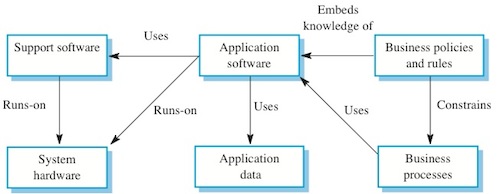Legacy system components
Figure 1 illustrates the logical parts of a legacy system and their relationships.

Figure 1. The parts of a legacy system
- System hardware Legacy systems may have been written for hardware that is no longer available, that is expensive to maintain and that may not be compatible with current organisational IT purchasing policies.
- Support software The legacy system may rely on a range of support software from the operating system and utilities provided by the hardware manufacturer through to the compilers used for system development. Again, these may be obsolete and no longer supported by their original providers.
- Application software The application system that provides the business services is usually composed of a number of separate programs which have been developed at different times. Sometime the term legacy system means this application software system rather than the entire system.
- Application data These are the data that are processed by the application system. In many legacy systems, an immense volume of data has accumulated over the lifetime of the system. This data may be inconsistent and may be duplicated in several files.
- Business processes These are processes that are used in the business to achieve some business objective. An example of a business process in an insurance company would be issuing an insurance policy; in a manufacturing company, a business process would be accepting an order for products and setting up the associated manufacturing process. Business processes may be designed around a legacy system and constrained by the functionality that it provides.
- Business policies and rules These are definitions of how the business should be carried out and constraints on the business. Use of the legacy application system may be embedded in these policies and rules.
Layered model of a legacy system

